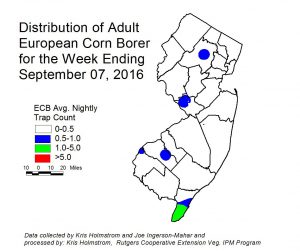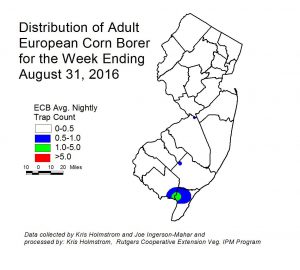Sweet Corn
 Low numbers of European corn borer (ECB) adults continue to be captured this past week. At the present time, highest activity remains in the Cape May-Cumberland County border area (see ECB map). Earlier ECB catches were extremely low, and these moths, likely representing a partial third flight, will not present much of a threat to host crops. This is particularly true in light of the dominance this year of fall armyworm (FAW). FAW will probably remain the larger threat, and treatments for this pest will eliminate ECB in the process. As always, consider treating when the number of infested plants in a 50 plant sample exceeds 12%. Any planting remaining at or above threshold as it proceeds to full tassel should be treated, as this is the last stage at which ECB larvae will be exposed and vulnerable to insecticidal sprays. See the 2016 Commercial Vegetable Recommendations Guide for insecticide choices.
Low numbers of European corn borer (ECB) adults continue to be captured this past week. At the present time, highest activity remains in the Cape May-Cumberland County border area (see ECB map). Earlier ECB catches were extremely low, and these moths, likely representing a partial third flight, will not present much of a threat to host crops. This is particularly true in light of the dominance this year of fall armyworm (FAW). FAW will probably remain the larger threat, and treatments for this pest will eliminate ECB in the process. As always, consider treating when the number of infested plants in a 50 plant sample exceeds 12%. Any planting remaining at or above threshold as it proceeds to full tassel should be treated, as this is the last stage at which ECB larvae will be exposed and vulnerable to insecticidal sprays. See the 2016 Commercial Vegetable Recommendations Guide for insecticide choices.
The highest nightly ECB catches for the previous week are as follows:
| Green Creek 2 | Hillsborough 1 |
| Allentown 1 | Lawrenceville 1 |
| Crosswicks 1 | New Egypt 1 |
| Downer 1 | Pedricktown 1 |
There has been no change in the fall armyworm (FAW) situation. Infestations continue throughout NJ, with high infestation rates in all parts of the state. This pest is devastating to small corn plants, and in fact the worst infestations are currently in shorter whorl stage plantings. Fields down to seedling stage should be scouted weekly for signs of infestation. We should expect this pest to be with us for the remainder of the sweet corn growing season. Treat when FAW alone or in combination with ECB damage exceeds 12% plants infested. FAW do not respond well to pyrethroid insecticides. The most useful products are those in the IRAC group 28 class (Coragen, Exirel) or the IRAC group 5 class (Radiant, Entrust), or combination products including these classes. See the 2016 Commercial Vegetable Recommendations Guide for insecticides effective against FAW.

